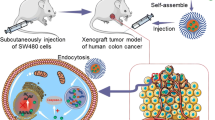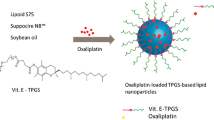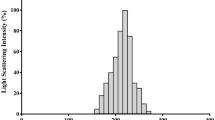Abstract
Recent treatments for malignant colon cancer in clinics are not efficacious and often result in deprived patient compliance due to short therapeutic efficacy and sturdy systemic side effects. To overcome this issue in the present study, we designed and formulated nanomaterial (PEGylated AuNPs-DOX@Kaempferol) for drug delivery system against colon cancer. The drug release behavior was subsequently studied at different pH. These results showed that the drugs have been released in controlled manner. The current investigation proves that the combination of DOX and Kaempferol are more efficient to induce cytotoxic effect while compared to the each drug alone. On the other hand, AO/EtBr and DAPI staining are confirming the induction of apoptosis in cancer cells. In vivo antitumor efficiency of PEGylated AuNPs-DOX@Kaempferol showed a significant reduction in tumor volume without any severe side effects. Thus, combine drug nanoformulations could be a promising drug delivery system for colon cancer therapy.

modified by polyethylene glycol. Doxorubicin and Kaempferol drug were binds with composite by number of hydrogen bond and electrostatic interaction. At acidic pH, discharge of DOX and Kaempferol molecules were achieved by breaking these interaction as well as drugs were released at intracellular regions, which showed greater anti tumour efficiency and also induced apoptosis in colon cancer












Similar content being viewed by others
References
J. Ferlay, I. Soerjomataram, R. Dikshit, S. Eser, C. Mathers, M. Rebelo, D. M. Parkin, D. Forman, and F. Bray (2015). Int. J. Cancer 136, E386.
M. Arnold, M. S. Sierr, M. Laversanne, I. Soerjomataram, A. Jemal, and F. Bray (2017). Gut 66, 691.
R. L. Siegel, K. D. Miller, and A. Jemal (2019). CA: A Cancer J. Clin. 69, 34.
R. L. Siegel, K. D. Miller, A. G. Sauer, S. A. Fedewa, L. F. Butterly, J. C. Anderson, A. Cercek, R. A. Smith, and A. Jemal (2020). Ca Cancer J. Clin. 70, 164.
E. Pavitra, B. Dariya, G. Srivani, S. Kang, A. Alam, P. Sudhir, M. Kamal, G. Seeta, R. Raju, Y. K. Han, V. B. K. S. Lakkakula, G. P. Nagaraj, and Y. S. Huh (2019). Semin Cancer Biol. https://doi.org/10.1016/j.semcancer.2019.06.017.
S. A. Ansari and Q. Husain (2012). Biotechnol. Adv. 30, 523.
K. Shanthi, K. Vimala, D. Gopi, and S. Kannan (2015). RSC Adv. 5, 44998.
W. Cai, T. Gao, H. Hong, and J. Sun (2008). Nanotechnol. Sci. Appl. 1, 32.
A. D. Mubarak, N. Thajuddin, K. Jeganathan, and M. Gunasekaran (2011). Colloids Surf. B 85, 360.
Z. Zhang, S. Xu, Y. Wang, Y. Yu, F. Li, H. Zhu, Y. Shen, S. Huang, and S. Guo (2018). J. Colloid Interface Sci. 509, 57.
T. Wu, X. Duan, C. Hu, C. Wu, X. Chen, J. Huang, J. Liu, and S. Cui (2019). Artif. Cells Nanomed. Biotechnol. 471, 523.
K. Huang, H. Maaa, and J. Liu (2012). ACS Nano 6, 4493.
J. Zhou, J. Ralston, R. Sedev, and D. A. Beattie (2009). J. Colloid Interface Sci. 331, 262.
Z. E. Ibrayeva, S. E. Kudaibergenov, E. A. Bekturov (2013). 376. Germany: LAP Lambert Academic Publishing.
J. Shan and H. Tenhu (2007). Chem. Commun. 44, 4598.
S. K. Bajpai, Y. M. Murali, and M. Bajpai (2007). J. Nanosci. Nanotechnol. 7, 3010.
B. Asadishad, M. Vossoughi, and I. Alamzadeh (2010). Biotechnol. Lett. 32, 54.
E. D. Stefani, P. Bofetta, H. Denco-Pellagrini, M. Mendilaharsu, J. C. Carzoglio, A. Ronco, and L. Olivera (1999). Nutr. Cancer 34, 110.
T. Fotsis, M. S. Pepper, E. Aktas, S. Breit, S. Rasku, H. Adlercreutz, K. Wahala, R. Montesano, and L. Schweigerer (1997). Cancer Res. 57, 2921.
E. J. Choi and W. S. Ahn (2008). Nutr. Res. Pract. 2, 325.
T. T. Nguyen, E. Tran, C. K. Ong, S. K. Lee, P. T. Do, T. T. Huynh, T. H. Nguyen, J. J. Lee, Y. Tan, C. S. Ong, and H. Huynh (2003). J. Cell. Physiol. 197, 121.
B. S. Raghavan, S. Kondath, R. Anantnarayanan, and R. Rajaram (2016). Nano Sci Technol. 3, 10.
J. E. Brown, H. Khodr, R. C. Hider, and C. A. Rice Evans (1998). J. Biochem. 330, 1178.
R. Thangam, P. Gunasekaran, K. Kaveri, G. Sridevi, S. Sundarraj, M. Paulpandi, and S. Kannan (2012). Process Biochem. 47, 1249.
S. Govindaraju, A. Roshini, M. Lee, and K. Yun (2019). Int. J. Nanomed. 14, 5157.
D. Dhamecha, S. Jalalpure, and K. Jadhav (2015). Process Biochem. 50, 2306.
H. Peng, D. Hong, Y. Guan, and S. Yao (2019). Int. J. Pharm. 558, 90.
S. Priyanka and S. Renu (2012). Int. Res. J. Pharm. 3, 187.
A. Halder, S. Das, T. Bera, and A. Mukherjee (2017). RSC Adv. 7, 14159.
B. S. Raghavan, S. Kondath, R. Anantanarayanan, and R. Rajaram (2015). Process Biochem. 50, 1976.
W. Zhang, D. Lin, H. Wang, J. Li, G. U. Nienhaus, Z. Su, G. Wei, and L. Shang (2017). Bioconjugate Chem. 28, 2229.
S. Agnihotri, S. Mukherji, and S. Mukherji (2014). RSC Adv. 4, 3983.
A. Mandal, V. Meda, W. J. Zhang, K. M. Farhan, and A. Gnanamani (2012). Colloids Surf, B 90, 196.
E. Illés, E. Tombácz, M. Szekeres, I. Y. Tóth, A. Szabó, and B. Iván (2015). J. Magn. Magn. Mater. 380, 139.
C. Barrera, A. Herrera, Y. Zayas, and C. Rinaldi (2009). J. Magn. Magn. Mater 321, 1399.
Y. Qin, W. Cui, X. Yang, and B. Tong (2016). Acta Biochim Biophys Sin. 48, 245.
G. Tomoaia, O. Horovitz, A. Mocanu, A. Nita, A. Avram, C. P. Racz, O. Soritau, M. Cenariu, and M. Tomoaia-Cotisel (2015). Colloids Surf. B Biointerfaces 135, 734.
J. Xiao, G. Sun, B. Sun, Y. Wu, L. He, X. Wang, R. Chen, L. Cao, X. Ren, and X. Sun (2012). Toxicology 292, 62.
F. Zhang and M. Cuimei (2019). Brazil. J. Med. Biol. Res. 52, 7843.
K. Vimala, K. Shanthi, S. Sundarraj, and S. Kannan (2017). J. Colloid Interface Sci. 488, 108.
T. A. Mary, K. Shanthi, K. Vimala, and S. Kannan (2016). RSC Adv. 6, 22936.
J. P. Singhal and A. R. Ray (2002). Biomaterials 23, 1145.
Y. S. Lin and C. L. J. Haynes (2010). Am. Chem. Soc. 132, 4842.
R. Bhanumathi, M. Manivannan, R. Thangaraj, and S. Kannan (2018). ACS Omega 3, 8328.
K. T. Oh, H. Yin, E. S. Lee, and Y. H. Bae (2007). J. Mater. Chem. 17, 4001.
Acknowledgments
This research work was supported by URF (University Research Fellowship), (Grant Number: PU/AD-3/URF/2016) Govt. of India. S.K/D.M. acknowledges and thankful to the EM facility center, All India Institute of Medical Sciences (AIIMS), New Delhi for EM analysis. K.V. acknowledges and thankful to UGC-Postdoctoral Fellowship, (Grant Number: PDFWM-2015-17-TAM-36122) University Grant Commission, New Delhi. We thank the Department of Zoology, Periyar University, Salem.
Author information
Authors and Affiliations
Corresponding author
Ethics declarations
Conflict of interest
No conflict of interest was reported by the author of this article.
Additional information
Publisher's Note
Springer Nature remains neutral with regard to jurisdictional claims in published maps and institutional affiliations.
Rights and permissions
About this article
Cite this article
Meena, D., Vimala, K. & Kannan, S. Combined Delivery of DOX and Kaempferol using PEGylated Gold Nanoparticles to Target Colon Cancer. J Clust Sci 33, 173–187 (2022). https://doi.org/10.1007/s10876-020-01961-x
Received:
Accepted:
Published:
Issue Date:
DOI: https://doi.org/10.1007/s10876-020-01961-x




